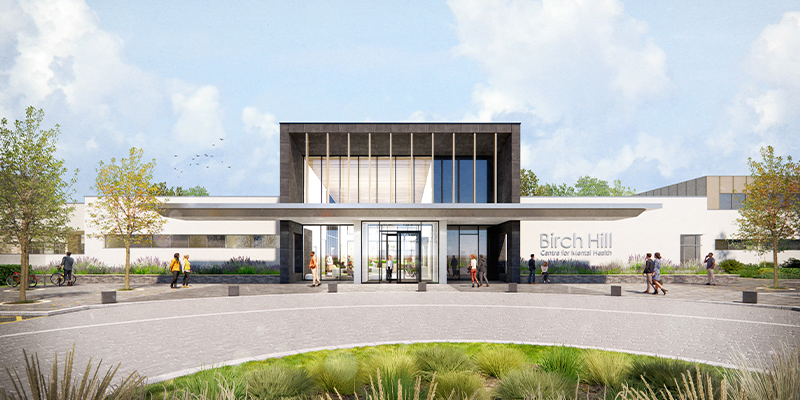Comment
Embedding care for mental health within the built environment
Senior Planner, Andrew Heasley explores how innovative planning principles and thoughtful design can be incorporated to ensure new developments meet higher standards of mental care, following the Royal Town Planning Institute (RTPI) Mental Health and Town Planning guidance. He illustrates the application of the impactful strategies at the proposed Birch Hill Centre for Mental Health and how the development has maintained mental health care at its core.
In recent years, the importance of mental health wellbeing has risen to the forefront in various sectors, including planning and architecture, catalysing conversations within the built environment. In October 2020, the RTPI published ‘Mental Health & Town Planning – Building in Resilience’, providing advice on how planners can incorporate mental health considerations into the built environment, within the UK planning system. It summarises expert advice, outlines key planning policy, good practice and case studies. The policy context applies to England, Wales, Scotland, Northern Ireland and Ireland, but the principles of good practice apply wherever you work.
Guidance and principles
Through the use of case studies, the RTPI recommend that environments designed for positive mental health can be achieved in a variety of ways – including creating pedestrian-friendly places and introducing new greenspace. This can include:
- Encouraging inclusive and connected communities
- Creating a pedestrian friendly place
- Introducing new greenspace
- Protecting inner city access to greenspace
- Refusing permission for isolated retirement housing
- Restoring local pride
- Temporary solutions to vacant site
By prioritising spaces that foster social interactions, ensuring easy access to natural spaces and embedding opportunities for physical activity, such as through increased walkability, stress can be reduced, a sense of belonging enhanced and overall mental health improved. Further, housing strategies that prevent the isolation of the elderly, reflect local culture and heritage, plus make the most of empty spaces can further contribute to better mental wellbeing.
Specific advice on the design of educational and health is also explained through the use of a number of exemplar case studies from across the UK. The proposed Birch Hill Centre for Mental Health shares similarities with the Dumfries & Galloway Royal Infirmary in Scotland, which is noted as an exemplar case study.
Actualising the guidance at Birch Hill Centre for Mental Health
Pre-application community consultation on proposals for the £126m new Birch Hill Centre for Mental Health were recently undertaken by Turley, Kennedy FitzGerald Architects, Arcadis and Tetratech on behalf of the Northern Health & Social Care Trust.
The proposals aim to centralise inpatient Mental Health Services of the Trust in modern, purpose-built accommodation, replacing the current provision at Holywell Hospital, Antrim and the Ross Thomson Unit at Causeway, Coleraine. While staff within these services continue to work hard to provide high quality, compassionate assessment and treatment, the design of the existing buildings does not always support this approach. As such, services from both these sites will be relocated to the new Birch Hill Centre for Mental Health.
The new facilities include a low-rise building design, that will provide 134 single-occupancy ground-floor rooms for patients, giving direct access to safe outdoor space and facilitating ease of movement between departments. The development prioritises links to nature and views of the neighbouring countryside, to ensure the best possible environment to support recovery.
The building design also prioritises sustainable design principles, with a target rating of BREEAM ‘Excellent’, a leading global standard for assessing the environmental performance of buildings. This should ensure the buildings performance is more energy efficient and have reduced operating costs helping deliver against net carbon zero targets and improve whole life performance.

Image credit: Kennedy FitzGerald Architects and Arcadis
Delivering on mental health excellence
Both Birch Hill Centre for Mental Health and Dumfries & Galloway Royal Infirmary designs maximise their rural setting and bring the wider landscape in to their sites. Research has shown that nature results in positive health outcomes and faster healing times. The hospitals are designed around a series of gardens and courtyards. These features optimise views and natural daylight. This creates an uplifting, therapeutic and patient centred environment.
In the Dumfries project, a senior Council planning officer was embedded in weekly NHS progress meetings from early in the PAD stage. The Birch Hill Centre for Mental Health hasn’t required the same level of input however the level of support and interest shown by Antrim & Newtownabbey BC Planning Department has been outstanding and is greatly appreciated by the project team. This collaborative approach to facilitating the PAD should result in a positive planning application process.
A similar approach has been applied to the statutory pre-application community consultation process. In advance of the recent consultation period the Trust engaged directly with neighbours through direct mail and regularly updated a project website to explain the planning strategy and programme. This has resulted in a positive consultation process to date and can reduce the risk of objection following the submission of the planning application that is scheduled for mid-December 2023. Subject to planning permission being granted, the Birch Hill Centre for Mental Health is scheduled to open in 2027/28.
Looking ahead
As we look ahead towards future developments, the increased integration of mental health considerations represent a positive shift in how we can progress our built environment. As exemplified at Birch Hill Centre for Mental Health, through prioritising these key aspects of mental health care, we can significantly elevate the standards these areas offer to the overall wellbeing of individuals and communities. To continue the conversation and explore how to better integrate mental health care into our built environment, please contact Senior Planner, Andrew Heasley.
15 December 2023
Images credit and courtesy of Kennedy FitzGerald Architects and Arcadis